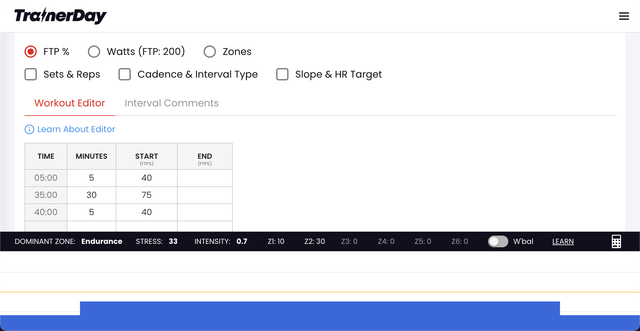How to Use the Workout Creator

The workout creator is one of TrainerDay's core features, and based on what users tell me, it's both powerful and straightforward once you know the basics. Let me walk you through how to build custom workouts that match exactly what you're trying to achieve.
Getting Started with Basic Workouts
Creating a workout starts with the fundamentals. I'll use a simple example: start with a 5-minute warm-up at 40 to 65% of FTP in ERG mode. From there, you can build out your main sets and recovery periods.
The workout creator uses a grid system where you program your intervals. Each row represents a segment of your workout, and you can specify the duration, power targets, and training mode for each segment.
Understanding Training Modes
One thing users ask about frequently is how to set up different training modes within a single workout. The workout creator supports automatic switching between ERG mode, slope mode, and heart rate mode. This means you can design a workout that starts with a controlled ERG warm-up, switches to slope mode for some varied terrain simulation, and then moves to heart rate targets for your cool-down.
For heart rate-based workouts specifically, several users have asked about setting target BPM rather than power references. The system does support HR-based intervals, though the exact setup process depends on whether you're targeting heart rate zones or specific BPM ranges.
Working with the Grid Interface
The grid where you program your numbers can feel a bit rigid at first. Users have mentioned wanting easier ways to add or delete rows mid-workout. While the interface has its quirks, you can build complex interval structures by planning out your segments in advance.
If you're creating workouts with progressions - like moving from four 5-minute intervals with 2-minute rest to 1-minute rest, then adding another interval block - you'll want to think about saving variations rather than trying to modify existing workouts extensively.
Advanced Features: W'bal Integration
For more sophisticated interval design, the workout creator integrates with W'bal calculations. Turn on the W'bal feature, enter your FTP (or CP if you know it), and input your W' value. This lets you design intervals that account for your anaerobic capacity and recovery, creating more precise training stimuli.
This is particularly useful for designing workouts that push your limits without completely depleting your anaerobic reserves too early in the session.
Saving and Organizing Your Workouts
Once you create a workout, it gets saved to your library. You can add workouts to favorites or create custom lists to organize them. These lists sync with the mobile training app, so your custom workouts are available when you're ready to train.
If you want to create variations of a workout, there's a duplication feature - hold the ALT key and drag to create a copy. Edit the details you want to change, and those modifications will be reflected in the duplicated version.
Multi-Sport Considerations
The workout creator works for cycling primarily, though users have asked about running plan integration. Currently, the main focus is cycling workouts, but the system does support different sport profiles with separate FTP settings. This means you can use it with different equipment types, each with their own power or effort targets.
Integration with Other Platforms
Your created workouts aren't locked into TrainerDay. The system supports exporting workouts to other platforms, and you can also import from various sources. This flexibility means you can design in TrainerDay and execute wherever works best for your setup.
Quick Creation Tips
The fastest way to build a workout is to think in segments: warm-up, main set, recovery, cool-down. Build each segment with its specific targets and modes, then let the system handle the transitions. For repeated intervals, you can set up the pattern once and specify the number of repetitions.
The workout creator really shines when you combine it with your performance data. Use your actual FTP, heart rate zones, and W' values to create workouts that match your current fitness level and training goals.
Whether you're building simple endurance rides or complex interval sessions, the key is starting with your training objective and working backward to the specific power, heart rate, or effort targets that will get you there.
Related Articles
Guide to Target Modes (ERG, HR+, Slope)
One of the biggest advantages of TrainerDay is how you can mix and match different control modes within a single workout...
Guide to Dynamic Workout Editing
Making quick changes to your workouts during training can be fun. Based on what I've seen from TrainerDay users, there a...
Guide to Dynamic "Feel-based" Training
Learn how to effectively use TrainerDay's feel-based training features to optimize your workouts based on your body's da...
Ready to Optimize Your Training?
Join thousands of cyclists using TrainerDay to reach their performance goals.
Start Training with TrainerDay
